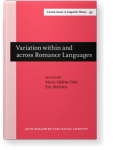Schwa at the phonology/syntax interface
It is claimed in this paper that the well known incongruence between the phonology and the syntax is resolved by removing syntactic boundaries by means of the rhythmic patterning. Resulting from this is a direct interface between the phonological phrasing and the syntax. The intermediary of the prosodic component is thereby eliminated. Accordingly, it is emphasized that language is rhythmic and that the rhythm of any given language directly interprets the syntactic constituency. The instrument by which this is achieved is the rhythmic foot, which contravenes the syntactic constituency directly and restructures it to align it with the rhythmic patterning. In contrast to Nespor (1990), therefore, this approach takes into account no separation between the prosody and rhythm. As a result, it limits the need for pre-compiled rules as proposed by Hayes (1990). Especially targeted in relation to this discussion is the behavior of French schwa.
References (34)
References
Bickmore, Lee. 1990. “Branching Nodes and Prosodic Categories”. Inkelas & Zec, eds., 1–17.
Blanche-Benveniste, Claire. 2000. Approches de la langue parlée en français. Paris: Ophrys.
Chen, Matthew. 1990. “What Must Phonology Know about Syntax?”. Inkelas & Zec, eds., 19–46.
Côté, Marie-Hélène. 2004. “Syntagmatic Distinctness in Consonant Deletion”. Phonology 21.1–41. 

Côté, Marie-Hélène. 2007. “Rhythmic Constraints on the Distribution of Schwa in French”. Romance Linguistics 2006: Selected papers from the 36th Linguistic Symposium on Romance Languages ed. by José Camacho, Nydia Flores-Ferrán, Liliana Sánchez, Viviane Déprez & María José Cabrera, 81–95. Amsterdam & Philadelpia: John Benjamins. 

Côté, Marie-Hélène & Geoffrey S. Morrison. 2007. “The Nature of the Schwa-Zero Alternation in French Clitics: Experimental and non-experimental evidence”. Journal of French Language Studies 17.150–186.
Dell, François. 1985. Les règles et les sons. 2nd ed. Paris: Hermann.
Hannahs, S.J. 1995a. Prosodic Structure and French Morphophonology. Tübingen: Max Niemeyer. 

Hannahs, S.J. 1995b. “The Phonological Word in French”. Linguistics 33.1125–1144. 

Hayes, Bruce. 1990. “Precompiled Phrasal Phonology”. Inkelas & Zec, eds., 85–108.
Hoskins, Steven. 1994. “Secondary Stress and Stress Clash Resolution in French: An empirical investigation”. Issues and Theory in Romance Linguistics ed. by Michael L. Mazzola, 35–47. Washington, D.C.: Georgetown University Press.
Inkelas, Sharon & Draga Zec, eds. 1990. The Phonology-Syntax Connection. Chicago: University of Chicago Press.
Inkelas, Sharon & Draga Zec. 1995. “Syntax-Phonology Interface”. The Handbook of Phonological Theory ed. by John A. Goldsmith, 535–549. Oxford: Blackwell.
Kaisse, Ellen. 1985. Connected Speech: The interaction of syntax and phonology. San Diego: Academic Press.
Léon, Pierre. 1966. La prononciation du français standard. Paris: Didier.
Martin, Philippe. 1979. “Sur les principes d’une théorie syntaxique de l’intonation”. Problèmes de prosodie ed. by Pierre Léon & Mario Rossi, 91–101. Ottawa: Marcel Didier.
Martin, Philippe. 1981. “L ’ intonation est-elle une structure congruente à la syntaxe?”. L ’ Intonation. De l ’ acoustique à la sémantique ed. by Mario Rossi, 234–271. Paris: Klincksieck.
Mazzola, Michael L. 1991. “Stress Clash and Segment Deletion”. Theoretical Analyses in Romance Linguistics ed. by Christiane Laeufer & Terrell Morgan, 81–97. Amsterdam & Philadelphia: John Benjamins. 

Mazzola, Michael L. 1993. “French Rhythm and French Segments”. Linguistic Perspectives on the Romance Languages: Selected Papers from the XXI Linguistic Symposium on Romance Languages, Santa Barbara, February 21–24, 1991 ed. by William Ashby, Marianne Mithun, Giorgio Perissinotto & Eduardo Raposo, 113–126. Amsterdam & Philadelphia: John Benjamins. 

Mazzola, Michael L. 1994. “Indirect Phonology and French Segments”. Generative French Phonology: Retrospective and perspectives ed. by Chantal Lyche, 191–209. Salford: Association for French Language Studies & European Research Institute.
Mazzola, Michael L. 1996. “Syntactic Constituency and Prosodic Phenomena”. Aspects of Romance Linguistics: Selected papers from the Linguistic Symposium on Romance Languages XXIV ed. by Claudia Parodi, Carlos Quicoli, Mario Saltarelli & Maria Luisa Zubizarreta, 313–327. Washington, D.C.: Georgetown University Press.
Mazzola, Michael L. 1998. “Suprasegmental Constituency as the Domain for Sandhi Variation”. Proceedings of the 16th International Congress of Linguists ed. by Bernard Caron. CD-Rom #0175. Oxford: Pergamon Press.
Mazzola, Michael L. 2001. “Prosodic Domains for Segment Deletion”. 1999 Mid-America Linguistics Conference Papers ed. by Michael Henderson, 285–294. Lawrence, Kan.: Linguistics Department, University of Kansas.
Mazzola, Michael L. 2006. “Rhythm and Prosodic Change”. Historical Romance Linguistics: Retrospective and perspectives ed. by Deborah Arteaga & Randall Gess, 97–110. Amsterdam & Philadelphia: John Benjamins. 

Morin, Yves-Charles. 1974. “Règles phonologiques à domaine indéterminé: Chute du cheva en français”. Cahier de linguistique 4.69–88. 

Nespor, Marina. 1990. “On the Separation of Prosodic and Rhythmic Phonology”. Inkelas & Zec, eds., 241–258.
Nespor, Marina, & Irene Vogel. 1986. Prosodic Phonology. Dordrecht: Foris.
Odden, David. 1987. “Kimatuumbi Phrasal Phonology”. Phonology Yearbook 4.13–26. 

Passy, Paul. 1899. Les sons du français. Paris: Firmin-Didot & Société des Traités.
Selkirk, Elizabeth. 1984. Phonology and Syntax: The relation between sound and structure. Cambridge, Mass: MIT Press.
Tranel, Bernard. 1987. The Sounds of French. New York: Cambridge University Press. 

Zec, Draga & Sharon Inkelas. 1990. “Prosodically Constrained Syntax”. Inkelas & Zec, eds., 365–378.
